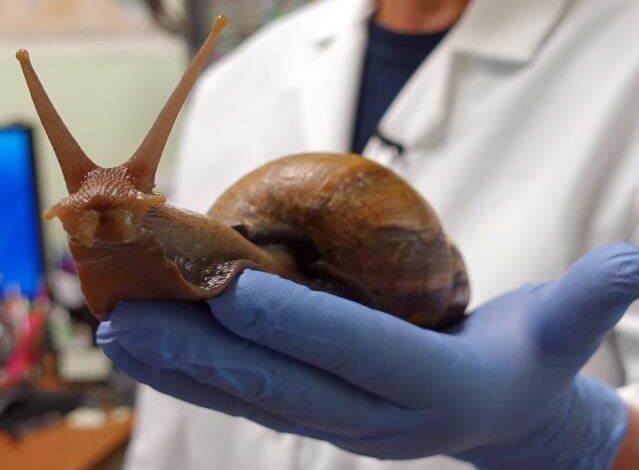Giant African land snail spotted in Florida; section of county under quarantine, say officials.
The snail has a reputation for consuming a minimum of 500 various plant species.

According to the Florida Department of Agriculture and Consumer Services (FDACS), a specific area within a county in Florida has been placed under quarantine while state officials take action to eliminate a massive African land snail (GALS).
FDACS reported that the quarantine was implemented in the Miramar area of Broward County, Florida, several weeks after the snail’s discovery. The FDACS emphasized that Giant African land snails are highly damaging to agriculture.
According to the United States Department of Agriculture, the snail has a documented appetite for over 500 economically significant plant species. These include breadfruit, cassava, cocoa, papaya, peanut, rubber, various types of beans and peas, cucumbers, melons, as well as plants with horticultural, cultural, and medicinal importance.
As per the FDACS, individuals are prohibited from relocating the giant African land snail from the affected area without a formal agreement, under the regulations of the quarantine.
Under the guidelines of the Florida Department of Agriculture and Consumer Services, it is prohibited to remove affected plants, soil, yard waste, debris, compost, or building materials from the designated quarantine zone.
According to the FDACS, state authorities will employ the pesticide metaldehyde to address the situation, as it is authorized for use in certain vegetables, crops, fruits, and residential plants.
Before the pesticide treatment commences, individuals residing in the designated treatment area will receive prior notification from state officials, at least one day in advance.
On its website, the FDACS explained that metaldehyde functions by interfering with the mucus production capacity of snails and slugs. This hinders their digestion and movement, rendering them vulnerable to dehydration. Snails and slugs that have consumed Metaldehyde typically exhibit behaviors such as seeking shelter, becoming inactive, and ultimately perishing within a matter of days.
According to the USDA, Giant African land snails (GALS) were initially introduced to Miami in 1966, and by 1973, more than 18,000 snails and their eggs were identified and eliminated.
According to state officials, the snails were declared eradicated in Florida on two occasions. The first declaration occurred in 1975 after their initial sighting in 1969, and the second declaration took place in 2021 following their appearance in Miami-Dade County in 2011.
It is worth noting that the giant African land snail is not the sole agricultural pest of concern.
Last year, scientists and multiple state agriculture departments advised individuals to crush the spotted lanternfly upon encountering it due to its detrimental impact on agriculture.
The origin of the spotted lanternfly can be traced back to Asia. However, its initial discovery in the United States occurred in Pennsylvania in 2014, followed by subsequent findings in other Northeastern states such as Connecticut, Delaware, Maryland, New Jersey, New York, and Virginia.
